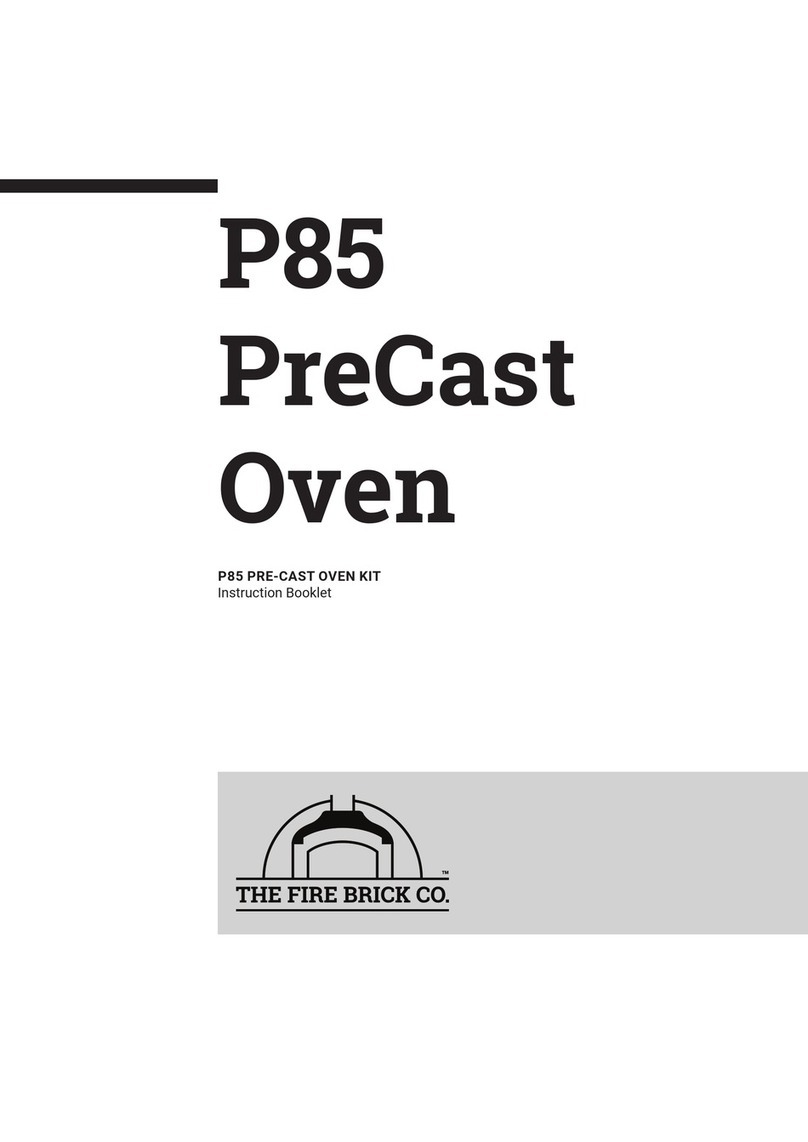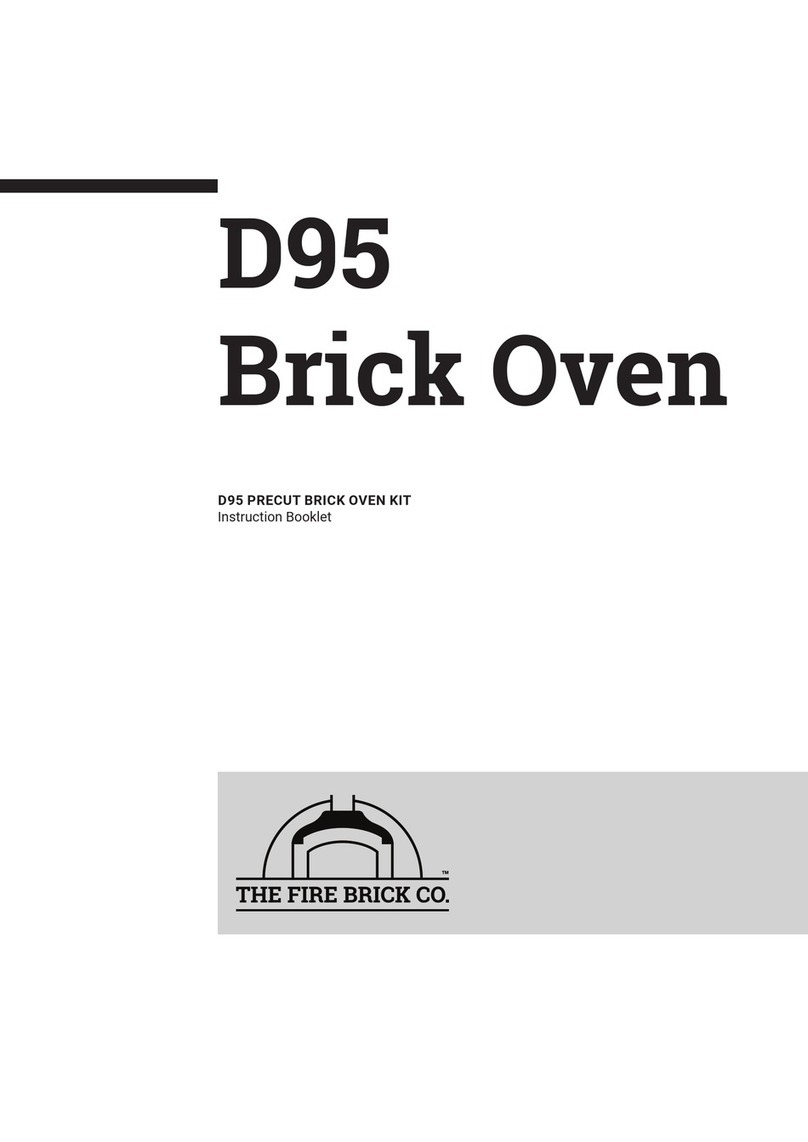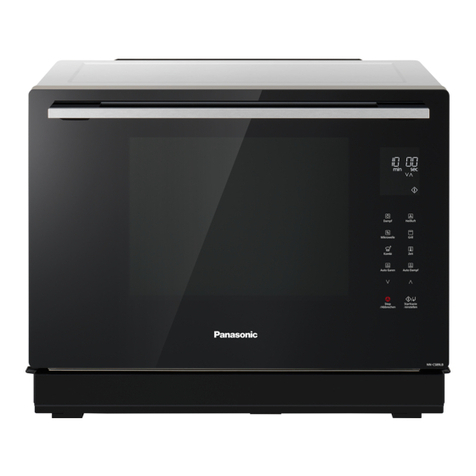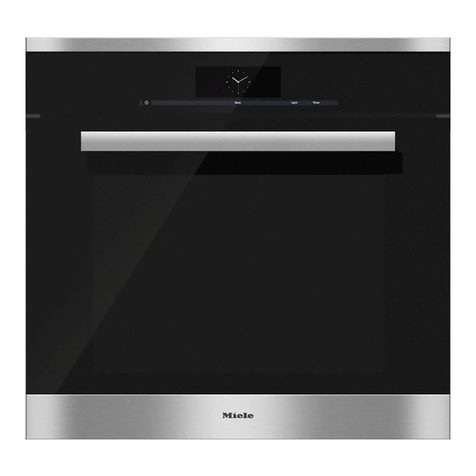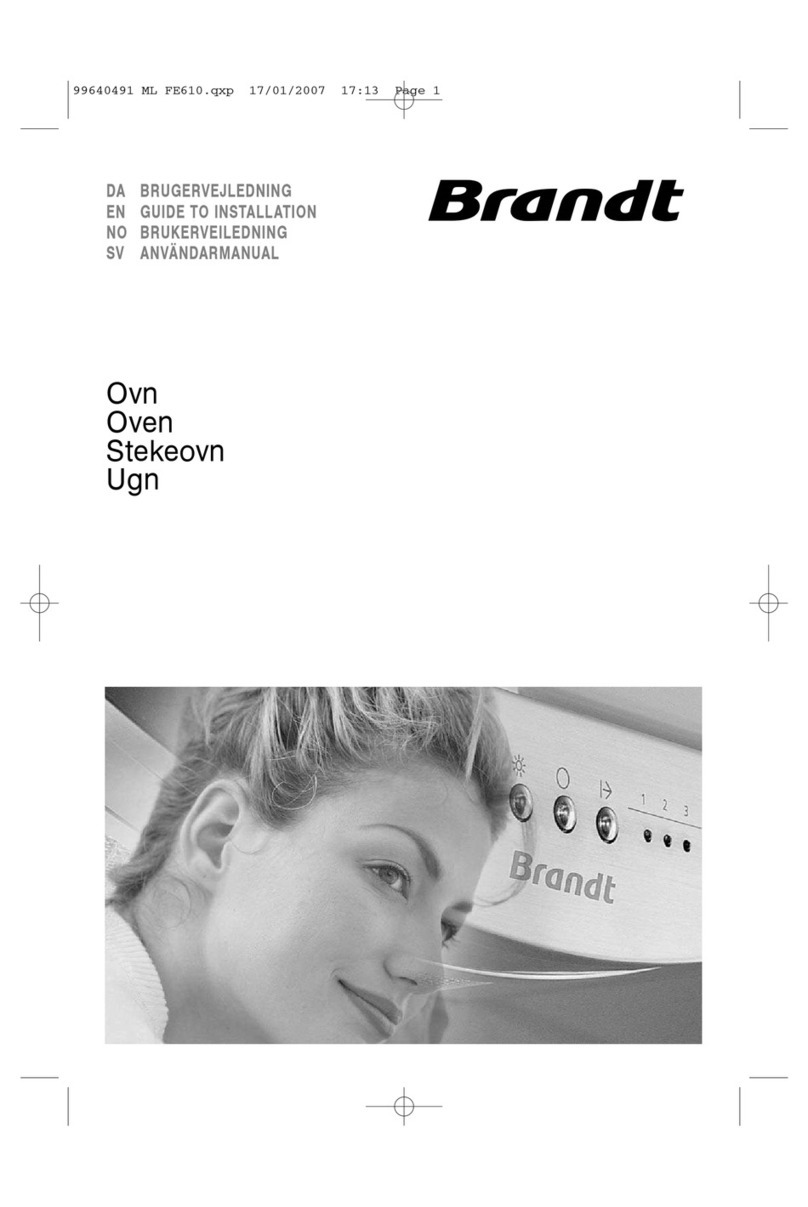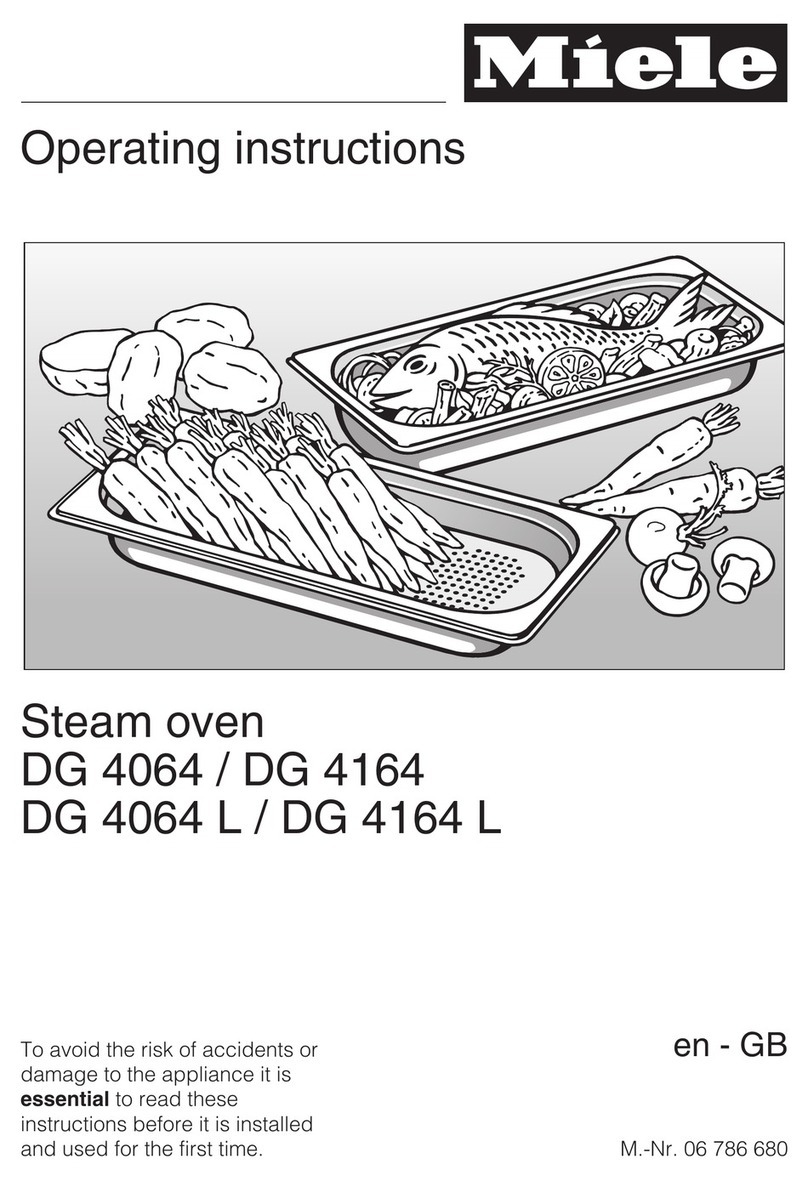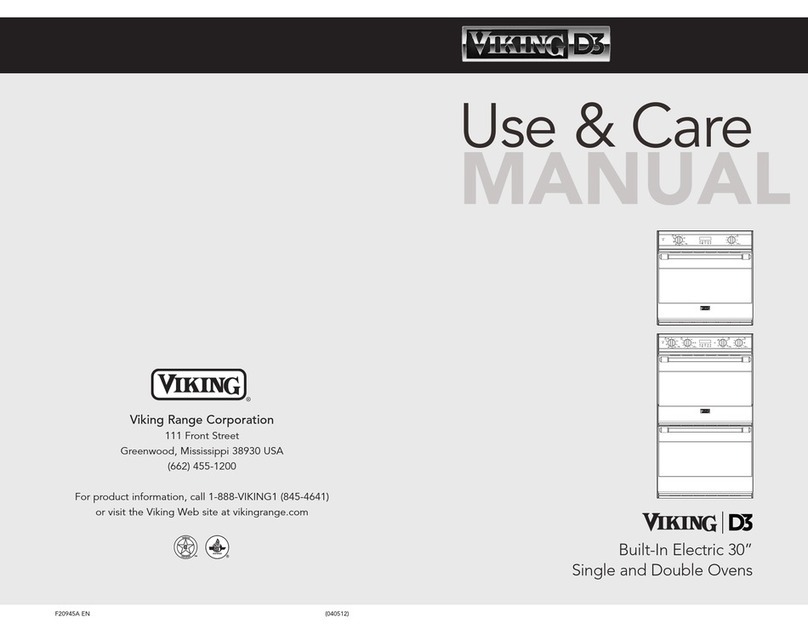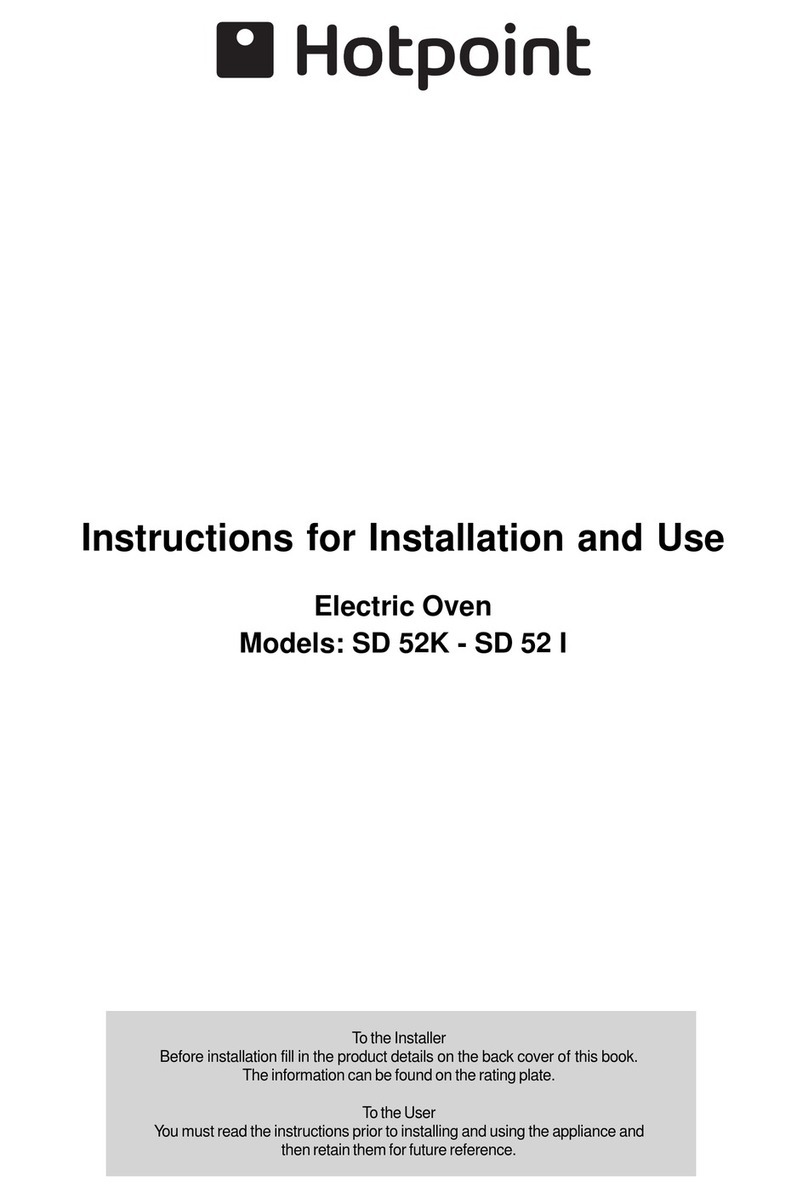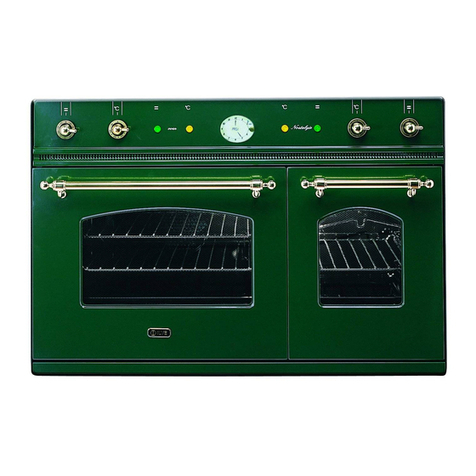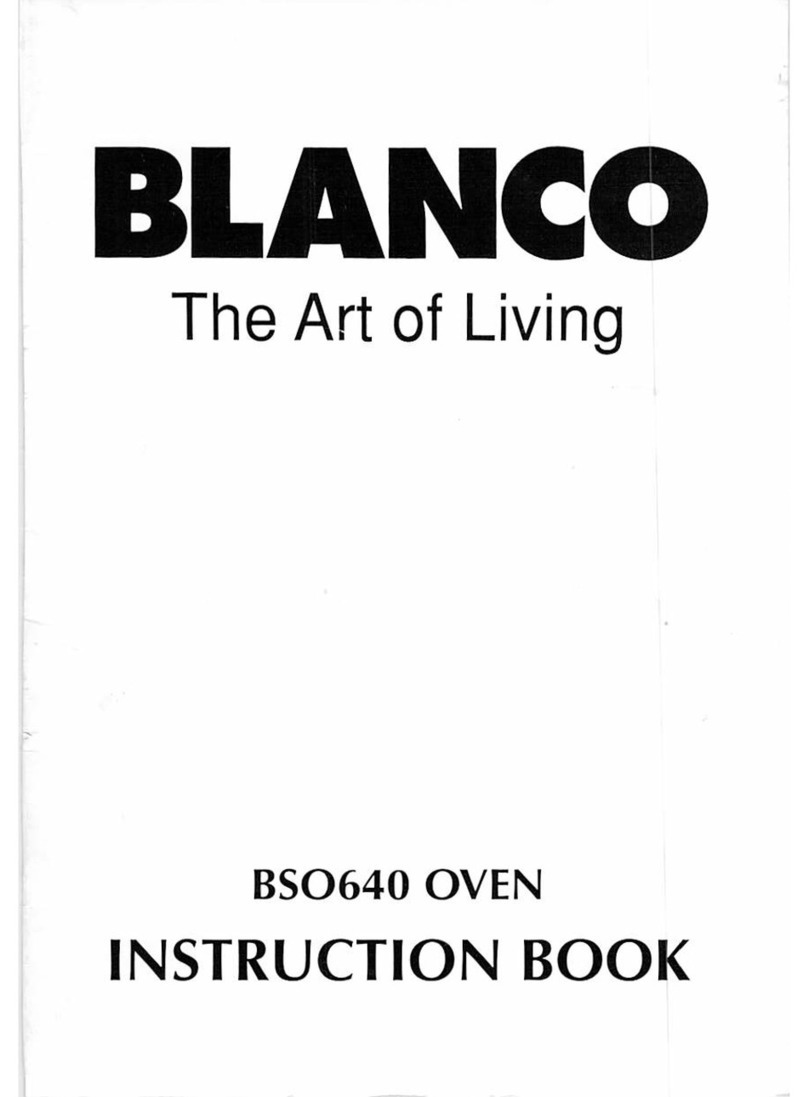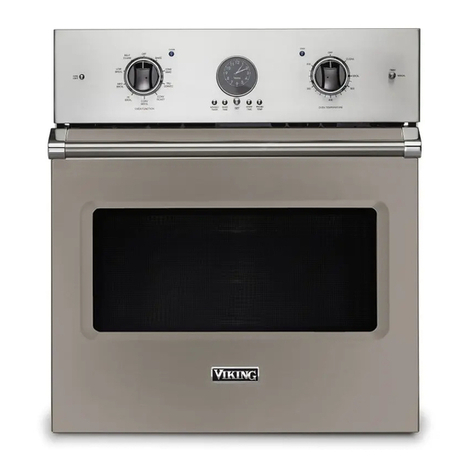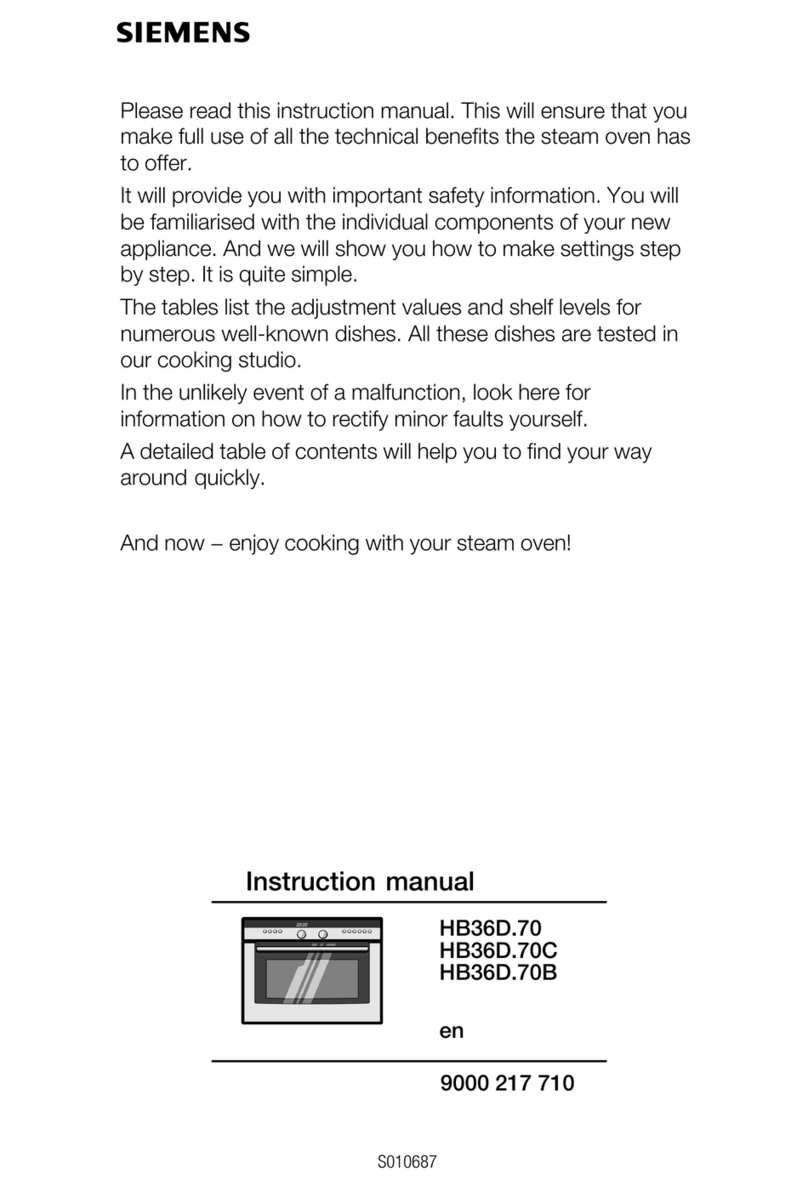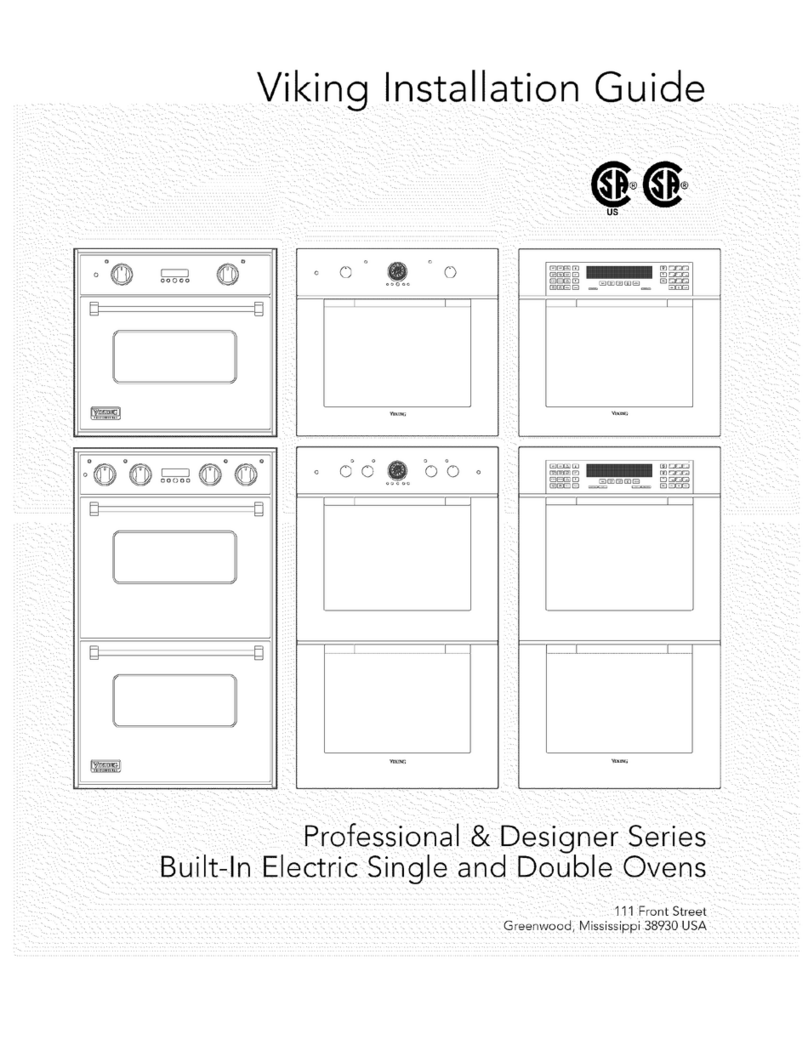The Fire Brick D130 User manual

D130
Brick Oven
D130 PRECUT BRICK OVEN KIT
Instruction Booklet

2
Our Wood Fired Brick
Oven Kits are as
authentic as you can
get. With all the re
bricks cut to size, with
custom formwork and
tooling, building a
quality Brick Oven has
never been so simple.
D130

3
Table of Contents
CONTENTS
INTRODUCTION � � � � � � � � � � � � � � � � � � � � � � � � � � � � � � � � � � � � � � � � � � � � � � � � � � � � � � � � � � 5
BEFORE YOU BEGIN � � � � � � � � � � � � � � � � � � � � � � � � � � � � � � � � � � � � � � � � � � � � � � � � � � � � � � � 6
NOTES & UPDATES� � � � � � � � � � � � � � � � � � � � � � � � � � � � � � � � � � � � � � � � � � � � � � � � � � � � � � � � 7
SAFETY INFORMATION � � � � � � � � � � � � � � � � � � � � � � � � � � � � � � � � � � � � � � � � � � � � � � � � � � � � 8
LIMITED WARRANTY � � � � � � � � � � � � � � � � � � � � � � � � � � � � � � � � � � � � � � � � � � � � � � � � � � � � � 12
LAYOUT DRAWING � � � � � � � � � � � � � � � � � � � � � � � � � � � � � � � � � � � � � � � � � � � � � � � � � � � � � � � 13
WHAT’S IN THE KIT � � � � � � � � � � � � � � � � � � � � � � � � � � � � � � � � � � � � � � � � � � � � � � � � � � � � � � 15
ADDITIONAL TOOLS & MATERIALS REQUIRED � � � � � � � � � � � � � � � � � � � � � � � � � � � � � � � 18
SUBFLOOR INSULATION � � � � � � � � � � � � � � � � � � � � � � � � � � � � � � � � � � � � � � � � � � � � � � � � � � 19
LAYING THE FLOOR TILES� � � � � � � � � � � � � � � � � � � � � � � � � � � � � � � � � � � � � � � � � � � � � � � � � 21
BUILDING THE DOME� � � � � � � � � � � � � � � � � � � � � � � � � � � � � � � � � � � � � � � � � � � � � � � � � � � � � 25
INSTALLING THE FLUE GALLERY� � � � � � � � � � � � � � � � � � � � � � � � � � � � � � � � � � � � � � � � � � � 37
INSULATING THE DOME � � � � � � � � � � � � � � � � � � � � � � � � � � � � � � � � � � � � � � � � � � � � � � � � � � 38
OVEN LANDING & SURROUNDS � � � � � � � � � � � � � � � � � � � � � � � � � � � � � � � � � � � � � � � � � � � � 40
PERLITE RENDER � � � � � � � � � � � � � � � � � � � � � � � � � � � � � � � � � � � � � � � � � � � � � � � � � � � � � � � � 41
INSTALLING THE STANDARD FLUE � � � � � � � � � � � � � � � � � � � � � � � � � � � � � � � � � � � � � � � � � 42
FLUE INSTALLATION TIPS � � � � � � � � � � � � � � � � � � � � � � � � � � � � � � � � � � � � � � � � � � � � � � � � 43
CURING THE OVEN� � � � � � � � � � � � � � � � � � � � � � � � � � � � � � � � � � � � � � � � � � � � � � � � � � � � � � � 44
PAINTING� � � � � � � � � � � � � � � � � � � � � � � � � � � � � � � � � � � � � � � � � � � � � � � � � � � � � � � � � � � � � � � 45

4
You really don’t need to
be a skilled bricklayer
to put this kit together -
we have done all of the
dicult work for you.
You get the fun part, of
putting it all together.
Introduction

5
Introduction
BEN GUILFORD
DIRECTOR
Firstly, our congratulations and gratitude for the purchase of your D130 PreCut Brick
Oven Kit! We have spent years crafting and perfecting our PreCut Brick Oven Kits,
taking suggestions from customers and mentors, to create a product that we are truly
proud of. We’re very blessed to say that we now have thousands of happy customers
around the world, enjoying time with family and friends over meals cooked in the most
authentic way possible.
That is what it’s all about in the end - you’re not just building a Wood Fired Oven.
You’re building something that’s going to bring your family and friends together in a
shared cooking experience. You’re building something that you will spend quality time
with the people that you love around, where you are forced to slow down and just enjoy
what you’ve built. You’re building something that you can use to love and serve others;
it’s rare to see someone re up their oven just to cook for themselves alone. It’s always
about community, it’s about loving and dare I say, spoiling the people closest to you.
If there’s a piece of outdoor equipment that draws people together more than an
authentic Wood Fired Oven, I’m yet to nd it. May your oven bring you, your family and
friends nothing but joy (and the occasional burnt crust) for many years to come.
Introduction
Introduction

6
Before You Begin
COLD CLIMATES - WARNING
If you’re building a Wood Fired Oven in a region that experiences ‘freeze-thaw’ conditions, where the frost is so
severe that it penetrates deep into the ground, this is something that you need to be aware of when deciding
on where and how to build your Wood Fired Oven.
The refractory bricks and insulation that make up our Wood Fired Oven Kits are very porous, so they will soak
up rain or melted snow that falls on them. This is not a problem in itself - if you re the oven up after the oven
has absorbed some water, the heat will drive the water out and the oven will return to its original state. However,
if your oven has gotten wet and experiences a deep frost, the water held in the re bricks and insulation may
freeze and expand, causing serious damage to the oven.
The sure way to prevent this is to build the oven into an enclosure that keeps it completely dry, so that when
the cold weather comes, it will have no adverse effect on the oven at all. If this is not possible, an alternative is
to re the oven thoroughly before the end of Autumn, then remove the ue and protect the oven with a suitable
weatherproof cover for the winter. The key is to keep the oven completely dry in deep cold conditions.
USING OUR INSTRUCTIONS
Building a Wood Fired Oven is a hugely enjoyable process, providing you take your time and pace yourself.
The best way to prepare for the build is to rst watch through the entire Instructional Video Series, from start
to nish. Then, read through these instructions in full so that you have a clear understanding of the process.
When you actually start building, take 15 minutes and watch the video that covers the part of the build that
you’re up to. These instructions are to help remind you of what you learned and give you more details where
they are needed. Remember, there is information in these instructions that is not in the videos, and vice versa.
That being said, if you’ve watched the videos, read the instructions and still feel even a little bit confused about
something, please call us right away� Part of what you’re paying for when you purchase one of our kits is
quality customer service - we are here to make sure you succeed in your Wood Fired Oven Building adventure!
Before You Begin

7
Notes & Updates
We are on a continuous search for ways to improve our products, so that we’re always giving our customers
the very best product that we can. These changes are always small and incremental - tested by us before being
rolled out to our customers. This is where we will make notes of these changes, where things have evolved
since the instructional videos were recorded.
1. The Refractory Mortar used to lay all of the bricks in the dome of the oven is now a two-part mix (in the
videos it was shown as a one part dry mix). This is to increase the shelf-life of the mortar, by keeping the
active ingredient separate in another bag. Close the tops of these bags after opening to help them keep.
2. The new Refractory Mortar mix used to lay the dome bricks sets far more quickly than its predecessor.
In the video series we suggest waiting until the following day to remove excess mortar from the inside
of the oven dome. We now recommend that you remove excess mortar as soon as possible, as it
will set very hard after 24 hours, particularly if you are building in a warm climate. This is especially
important when you are laying the nal courses of dome bricks on top of the breglass dome
formwork. If you are laying these nal courses over several days, it will be wise to lower the dome
formwork after you lay each course in order to remove excess mortar and clean your brickwork.
3. The D130 PreCut Brick Oven Kit is a Commercial Spec Wood Fired Brick Oven. As such it has more of
almost everything; 100mm of Calcium Silicate Suboor Insulation Board, 100mm of re brick as thermal
mass for the Oven Floor and 75mm of Ceramic Fibre Blanket to insulate the brick dome.
We achieve the 100mm of re brick in the oven oor by replacing the 25mm ‘Suboor Castable’ layer
seen in the videos with a 50mm re brick tile. This means the process is slightly different to what you’ll
see in the videos, but that is covered in detail in these instructions.
4. As the D130 PreCut Brick Oven is typically used in commercial applications, we recommend that you
use Refractory Castable for any large openings in the brickwork, rather than using the Refractory Mortar.
For example, after laying course 6 you’ll nd there are some large triangular gaps that need to be lled
where Course 7 crosses the Entry Arch. In the instructional video series we ll these gaps with Refractory
Mortar, for the D130 Brick Oven you need to use the Refractory Castable to ll these gaps.
Similarly for the ends of the brick courses - in the video series we used the Refractory Mortar to ll in the
‘keystones’ at either end of each course of dome bricks. For the D130 these gaps need to be lled either
using re bricks that have been cut/ground to size, or the Refractory Castable mixture.
This is because the D130 is likely to be pushed to much higher temperatures, much more often, than the
other ovens in our range.
Updates

8
Fire Safety
Safety Warning
A MAJOR CAUSE OF UNINTENDED OVEN-RELATED FIRE IS FAILURE TO MAINTAIN
REQUIRED CLEARANCES (AIR SPACES) TO NEARBY COMBUSTIBLE MATERIALS.
IT IS OF THE HIGHEST IMPORTANCE THAT THIS OVEN BE INSTALLED ONLY IN
ACCORDANCE WITH THESE INSTRUCTIONS.
IF THIS OVEN IS NOT PROPERLY INSTALLED, AN UNINTENDED FIRE MAY RESULT.
TO REDUCE THE RISK OF FIRE, FOLLOW THESE INSTALLATION INSTRUCTIONS.
PLEASE READ THIS SET OF INSTRUCTIONS IN FULL AND WATCH THE INSTRUCTIONAL
VIDEOS BEFORE INSTALLING AND USING YOUR OVEN.
FAILURE TO FOLLOW INSTRUCTIONS MAY RESULT IN FIRE, CARBON MONOXIDE
POISONING OR EXPLOSION LEADING TO PROPERTY DAMAGE, BODILY INJURY, OR
EVEN DEATH.
IF YOU HAVE ANY QUESTIONS AT ALL REGARDING THE SAFE INSTALLATION OF YOUR
OVEN, PLEASE DON’T HESITATE TO CONTACT US, WE’LL BE HAPPY TO ASSIST YOU.
Safety Information

9
Fire Safety
Clearances to Combustible Materials
A major cause of oven-related property re is failure to maintain the required clearances (air spaces) between
the oven and combustible materials. When planning the location for your oven, ensure that you maintain
clearances to all combustible materials, including but not limited to nearby walls, posts, ceiling structures and
vegetation.
If the oven is being built in close proximity to a structure (eg� beneath a pergola), the clearance from
combustible materials to the ue can be reduced by using a twin or triple skin ventilated ue system. If you’re
planning to do this the ue must be specied and installed by a licensed professional to ensure that the ue
system is compliant with the relevant standards and local laws for your area.
If in doubt, contact a qualied plumber or your local re authority for more information.
400mm
Above Oven
Clearance
750mm
Flue Clearance
750mm
Flue Clearance
700mm
Vent Brick &
Flue Gallery
Clearance
1200mm
Non Combustible
Floor Material
Clearance Zone
Combustible Material
Non Combustible
Material
Clearance Continues
50mm
Dome
Clearance
MINIMAL CLEARANCE ARE AS FOLLOWS;
50MM CLEARANCE TO COMBUSTIBLES
FROM ALL SIDES OF THE INSULATED
OVEN DOME�
400MM CLEARANCE TO COMBUSTIBLES
ABOVE THE INSULATED OVEN DOME�
750MM CLEARANCE TO COMBUSTIBLES
FROM ALL SIDES OF THE STAINLESS
STEEL FLUE (UNLESS A MULTI-SKIN FLUE
SYSTEM IS INSTALLED)�
700MM CLEARANCE TO COMBUSTIBLES
FROM ALL SIDES OF THE VENT BRICKS
AND PRECAST FLUE GALLERY�
COMPLETE CLEARANCE ABOVE THE
FLUE, MAINTAINING THE 750MM RADIUS
AROUND IT�
NON-COMBUSTIBLE FLOOR MATERIAL
SHOULD EXTEND 1200MM FROM THE
FRONT OF THE OVEN, FOR THE WIDTH OF
THE OVEN DOME, TO PROTECT AGAINST
FALLING HOT EMBERS�

10
Safe Installation Instructions
DUST EXPOSURE – RESPIRABLE CRYSTALLINE SILICA
Inhalation of airborne dust may cause irritation to the mucous membrane and upper airways. Symptoms can include coughing, sneezing
and breathing diculties. Repeated exposure to respirable silica may result in pulmonary brosis (silicosis). Silicosis is a bronodular lung
disease caused by deposition in the lungs of ne respirable particles of crystalline silica. Principal symptoms of silicosis are coughing
and breathlessness.
The following materials in your Wood Fired Oven Kit may contain respirable crystalline silica and a suitable dust mask should be worn
while handling them;
• Hybrid Refractory Bedding Mortar (marked Airset Mortar)
• Refractory Mortar Part A
• Refractory Mortar Part B
• Refractory Castable
• Fire bricks (when cutting or shaping them with a grinder)
• Perlite
• Calcium Silicate Board
While the Ceramic Fibre Blanket does not contain respirable silica, the bers are very irritating to the respiratory tract and can cause
irritation in the nose and throat, and chest discomfort. A suitable dust mask should be worn when working with the ceramic bre blanket,
until the rst layer of Perlite Render has been applied to seal the ceramic bre blanket from the atmosphere.
EYE PROTECTION
This is a very hands-on project and you are advised to wear safety glasses when mixing any of the materials or cutting/grinding bricks.
This also applies to applying the ceramic bre blanket insulation, which is irritating to the eyes. If in doubt, wear safety glasses!
SKIN PROTECTION
The mortar mixture that you’ll use to lay the re bricks in your Wood Fired Oven Kit is quite alkaline, and repeated exposure to your skin can
result in chemical burns. The same goes for the Refractory Castable and Perlite Render mixes. This is compounded by having to handle
wet bricks, which (if done without gloves) makes your skin softer and more vulnerable to being attacked by these materials. IGNORE THIS
AT YOUR OWN RISK! THE AUTHOR HAS PERMANENT SCARRING TO REMIND HIM OF THE IMPORTANCE OF WEARING GLOVES�
To avoid this, wear rubber ‘washing up’ gloves underneath ordinary gardening gloves to protect your skin. Rubber gloves alone may not
work well for long, as handling the re bricks can wear straight through them very quickly. There are some heavy duty rubber gloves
available at some supermarkers and hardware stores that work very well by themselves, as you will see in the instructional videos.
The key is to keep your hands dry, and if you notice a hole in the rubber gloves you would be well advised to replace them immediately.
Avoid rubber gloves with an elastic cuff at the wrist – these can rub your skin and leave it exposed to attack from the alkaline material
you’re handling. If your hands get wet inside the gloves, remove the gloves, dry your hands and put on a new pair of gloves, turning the
others inside out to dry so they can be used later. For this reason it’s worth having two pairs of rubber gloves.
The Ceramic Fibre Blanket can be irritating to the skin, with some people experiencing rash symptoms, so we have provided you with two
large plastic gloves that loop over your neck and cover the length of your arms. Wear these when handling the Ceramic Fibre Blanket.

11
Safe Usage Instructions
WARNING: PLEASE READ ALL OF THE INSTRUCTIONS BEFORE INSTALLING AND USING YOUR WOOD FIRED OVEN� FAILURE
TO FOLLOW INSTRUCTIONS MAY RESULT IN FIRE, CARBON MONOXIDE POISONING OR EXPLOSION LEADING TO PROPERTY
DAMAGE, BODILY INJURY, OR EVEN DEATH� SAVE THESE INSTRUCTIONS�
If your oven is not installed properly, an unintended re may result. To reduce the risk of such a re, please follow our installation instructions
carefully. It is critical to use only the materials specied and provided to construct the oven.
Contact your local Building Authority, or Fire Authority regarding local laws for installation of this oven in your area.
OVEN IS HOT WHILE IN OPERATION. KEEP CHILDREN, CLOTHING AND FURNITURE WELL CLEAR. CONTACT WITH UNINSULATED PARTS
OF THE OVEN INCLUDING THE BRICKWORK AND CHIMNEY FLUE MAY CAUSE SKIN BURNS.
DO NOT BURN FLAMMABLE LIQUIDS OR WASTE MATERIALS IN THE OVEN.
DO NOT CONNECT THIS OVEN TO A FLUE ATTACHED TO ANOTHER WOOD BURNING APPLIANCE.
Keep children and pets away from the oven when it is hot, DO NOT leave children near the oven unsupervised.
Use good quality rewood for burning only. DO NOT USE charcoal, pressure treated timber, sappy timber, laminated timber or any material
other than well dried rewood. This does not apply to kindling.
DO NOT USE liquid fuel (relighter uid, gasoline, lantern oil, kerosene or similar liquids) to start or maintain a re.
BEWARE of very high temperatures in the oven and use long oven mitts or welding gloves rated above 400°C to handle pots, pans and
uninsulated tools.
DO NOT put any unprotected part of your body inside the oven while it is hot. The oven can remain hot without a re.
DO NOT close the oven door fully while a re is burning in the oven. Closing the door fully will cut off oxygen to the re, causing the re to
are up violently if the door is then removed. This does not apply to hot coals.
Dispose of ashes using a metal shovel and place in a metal bin with a snug tting lid. The container should be stored on a non-combustible
surface, away from all combustible materials. It is not necessary to empty the ashes from the oven each time it is used, empty as required.
Ensure the ashes are completely cold before disposing of them in an appropriate manner.
VERY IMPORTANT - BEWARE of sparks and embers ying out from the oven opening, as rewood can crackle and pop, sending embers
ying. Ensure no combustible materials are within range of the oven at any time.
DO NOT use water to extinguish the re or cool down the oven.
DO NOT ll the clearance spaces around the oven with sand, insulation or any other material.
Follow the instructions for Curing the Oven with care. Failure to follow these instructions may cause damage to the oven, poses a safety
risk to those nearby, and can void the warranty.
FOR YOUR SAFETY do not store or use gasoline or other ammable liquids or vapours in close proximity to the oven.
Ensure that an able bodied person of suitable age, who’s judgment is not impaired by alcohol, drugs or medication is present to monitor
and control the re from the time that it is lit to the time that it is extinguished.
Ensure that a suitable dry chemical or CO2 re extinguisher is on hand when the oven is lit.
Inspect the ue regularly for any buildup of soot, and remove excess soot if it is found.
If the oven is being built indoors, check with your plumber to ensure that the building has adequate ventilation to feed the re without
lowering the quality of air in the room, or risking a buildup of carbon monoxide.

12
Limited Warranty
The Fire Brick Company, a manufacturer of wood red ovens, warrants its ovens (henceforth referred to as the Oven) to be free from
defects in materials and workmanship for a period of (1) one year from the date of purchase.
QUALIFICATIONS TO THE WARRANTY
The complete Product Warranty outlined above does not apply under the following circumstances:
1. The Oven was not installed in accordance with The Fire brick Company installation instructions and local building
codes.
2. The Oven has been subjected to non-standard use, such as burning fuels with abnormal burning characteristics including but
not limited to; driftwood, charcoal, plywood and material containing a binder that may burn at excessive temperatures and
cause damage to the Oven.
3. This Warranty does not apply to normal wear and tear.
4. This Warranty does not apply to any cracking caused by over-ring or the failure to follow a proper curing schedule.
5. On parts that would be normally worn or replaced under normal conditions.
6. Normal cracking due to expansion and contraction stress relief in the brickwork, precast ue gallery, render or oor tiles.
LIMITATION ON LIABILITY
It is expressly agreed and understood that The Fire brick Company’s sole obligation and purchaser’s exclusive remedy under this Warranty,
under any other warranty, expressed or implied, otherwise, shall be limited to replacement, repair, or refund, as specied above, and such
liability shall not include, and purchaser specically renounces any rights to recover, special, incidental, consequential or other damages
of any kind whatsoever, including, but not limited to, injuries to persons or damage to property, loss of prots or anticipated prots, or loss
of use of the Oven.
In no event shall The Fire brick Company be responsible for any incidental or consequential damages caused by defects in its Ovens,
whether such damage occurs or is discovered before or after replacement or repair, and whether or not such damage is caused by The Fire
brick Company’s negligence. Some regions do not allow the exclusion or limitation of incidental or consequential damages, so the above
limitation or exclusion may not apply to you. The duration of any implied warranty with respect to this Oven is limited to the duration of
the foregoing warranty. Some regions do not allow limitations on how long an implied warranty lasts, so the above may not apply to you.
INVESTIGATION OF CLAIMS AGAINST WARRANTY
The Fire brick Company reserves the right to investigate any and all claims against this Warranty and to decide upon method of settlement.
HOW TO REGISTER A CLAIM AGAINST WARRANTY
In order for any claim under this Warranty to be valid, The Fire brick Company must be notied of the claimed defect in writing or by
telephone to The Fire brick Company, Factory 11/167 Princes Hwy Hallam, Victoria 3803, Australia. Claims against this Warranty in writing
should include the date of installation, and a description of the defect.
Limited Warranty

13
D130 Layout Drawing
115 mm
Fire Brick Dome Wall
75 mm
Ceramic Fibre Insulation
50 mm
Perlite Render Insulation
7 inch
Stainless Steel Flue
2x Layers 50 mm
Fire Brick Tile Floor
PreCast
Flue
Gallery
2x Layers 50mm
Calcium Silicate Board
75 mm
Ceramic Fibre Insulation
50 mm
Perlite Render Insulation
115 mm
Fire Brick Dome Wall
1300 mm
Internal Diameter
500 mm
540 mm
~170 mm
Center of Flue
1780 mm
Overall Width
1880 mm
Overall Length
1050 mm
Flue Height
790 mm
Oven Height
~ 965 mm
External Dome Height
520 mm
Internal
Dome Height
335 mm 345 mm
7 inch
Layout Drawing

14
All of the bricks come
cut and ground to
size. We provide you
with templates, CNC
machined formwork, a
trammel tool, breglass
dome form and much
more. Your job is to
assemble the kit like a
big Lego set.
Kit Contents

15
Kit Contents
What’s In the Kit
CALCIUM SILICATE BOARD
8 x Calcium Silicate Boards 1000x615x50mm
This is the insulation underneath your oven; two layers of ‘Calsil’ Board for a total of 100mm of insulation,
double what we use in our domestic range. The printed paper templates and thumb tacks allow you to pin the
templates onto the CalSil board and cut out the pieces you need, following the lines shown on the templates.
FIRE BRICKS - DOUBLE FLOOR TILES
The Floor Tiles are all cut to size and ready to lay; the center tile has a 3mm hole pre-drilled in the middle for
the trammel tool to lock into. The re bricks used in the oven oor are 38% Alumina, rated to 1350°C with an
exceptionally hard wearing surface, and are 50mm thick. There are two layers of oor tiles in the D130, giving
you 100mm of re brick as the thermal mass for the oven oor - perfect for high turnover pizzerias.
FIRE BRICKS - OVEN DOME
All bricks for the Oven Dome are provided, carefully cut to keep the internal gaps on the inside face of the oven
to a minimum. These re bricks are 38% Alumina, rated to 1350°C and are 115mm thick.
REFRACTORY CASTABLE
1 x Novaref Refractory Castable 25kg bag and 1 x 6kg bag
Refractory Castable is premixed high temperature concrete, which you’ll use to ll any large gaps in your dome
brickwork, and for pouring the dome keystone. The 6kg bag is extra, just in case.
FIRE BRICKS - ENTRY & VENT ARCHES
The bricks for the Entry and Vent Arches that form the mouth of the oven are all cut to size from 38% Alumina
re bricks rated to 1350°C, ready to lay.
The Entry Arch Bricks (the opening into the dome) are machine-ground on their back face to follow the curvature
of the dome, to give you a smooth transition from the dome into the opening.
The Vent Arch Bricks are carefully selected as these will be on display at the front of the oven. They are all cut
to size, and are designed to lock into the Entry Arch for strength and stability.
FORMWORK - ENTRY & VENT ARCHES
We provide CNC machined timber formwork with your kit to construct the Entry and Vent Arches around, to
ensure that your brickwork is exactly as per our design. The Formwork is clearly marked to help you position
the arches accurately, and has machined markings showing the location and thickness of each mortar joint.
TRAMMEL TOOL & DOME TEMPLATE
The trammel is a tool that you will clamp each dome brick into, which is fully adjustable. At the start of each
row you will adjust the trammel to follow the CNC cut dome template, which follows our elliptical dome prole
for perfect pizza cooking. It has a hardened pin in the base that ts into the 3mm hole drilled in the center tile.
What’s Inside the Kit

16
What’s In the Kit
FIBREGLASS DOME FORMWORK
To lay the last several courses of bricks in the dome you will use our breglass dome formwork, custom made
to match the elliptical curve of the oven dome. It comes with a round timber support, to spread the load when
you jack it into position.
HYBRID REFRACTORY BEDDING MORTAR
Dry Airset Refractory Mortar: 1 x 20kg bag
This is the mortar you will use to lay the re brick tiles that make up the oven oor. Please be aware that you
will need to mix the Airset mortar with General Purpose Cement, Hydrated Lime and Washed Sand* in the ratio
shown on the bag. This makes a smooth hybrid mortar mix perfectly suited to bedding down re bricks for
oven oors.
REFRACTORY MORTAR (TWO PART MIXTURE)
Refractory Mortar Part A: 3 x 25kg bags
Refractory Mortar Part B: 1 x 25kg bag
This is the mortar you’ll use to lay all of the remaining bricks in the kit.
PRECAST FLUE GALLERY
The PreCast Flue Gallery is the molded section that ts over the brick arches at the front of the oven. Made
from refractory castable and reinforced with stainless steel bres, it’s tted with 7” Stainless Steel Flue sleeve,
ready to attach the ue section onto. A brushed stainless steel ring covers the ue expansion joint.
CERAMIC FIBRE BLANKET
Three full rolls of 25mm thick Ceramic Fibre Blanket are provided, which will give you three full layers over your
brick dome for 75mm coverage, which is 50% more than we use on our domestic oven range.
PERLITE RENDER
LiteFill Perlite: 3 x 100L bags + 1 x 50L bag
This is the material you will use to cover the Ceramic Fibre Blanket layer, which you will be mixing with GP
Cement, Hydrated Lime and Washed Sand* to make a high-build Render mixture. There is enough Perlite in
the kit to build up a 50mm shell of render over the oven dome, with plenty left in reserve if some is wasted on
accident.
STAINLESS STEEL FLUE & HAT
1 x 7” Stainless Steel Flue - 900mm Length
1 x 7” Stainless Steel Cowling
* Sand, Hydrated Lime and GP Cement are available at most hardware stores and need to be purchased in addition to the kit.
Kit Contents

17
Kit Contents
What’s In the Kit
ACRYLIC ROLL-ON BASECOAT RENDER
1 x 5L MAC ‘Rustic Roll-On’ Acrylic Render (White Basecoat)
This is the membrane coating that you will apply over the outer dome, once the oven has been completely
cured and all moisture has been driven out. It gives the dome a good waterproof basecoat which can be rolled
over with more roll-on render, or other similar exterior acrylic coating. It can be tinted at most paint stores.
OVEN DOOR
The nal part of your kit is our Stainless Steel oven door, coated in a satin black nish. The handles are
beautiful oiled hardwood, with solid stainless steel rings top and bottom. The door comes with a vacuum
sealed temperature gauge accurate to 550°C (packed inside the bag of extras within the door box).
EXTRA ITEMS PROVIDED
• Plastic Formwork for Sub-Floor Heat Bank • 24 x 125mm Nails
• Plastic Strips to support the Timber Formwork • 25 x 100mm Phillips Head Screws
• 2 Rolls of Chicken Wire & Galv Tie Wire • 2 x Long Sleeve ‘Vet Examination’ Gloves
OPTIONAL EXTRAS
WATERPROOFING SYSTEM
Roll of 150mm wide Aluminium Flashing and 1 x Cartridge of Sikasil High Temperature Silicone
To prevent rain being drawn into the oven from beneath the outer dome (the perlite render layer), install our
waterproong system around the oven perimeter prior to rendering. Only needed for outdoor installations.
HIGH TEMP SPRAY PAINT FOR PRECAST FLUE GALLERY
Spray can of PPG Temptec 328 in Satin Black. Great for painting the Flue Gallery to make it look sharp.
OVEN WALL TEMPERATURE PROBE WITH THERMOWELL
250mm Temperature Gauge with Stainless Steel Thermowell that can be mounted through the oven wall.
POLISHED GRANITE LANDING
Polished Granite sections cut to t around the Vent area, giving you somewhere to pull out heavy roasting trays
to check on your cooking. Also an important surface to allow you to use your Oven Door as a Draft Door.

18
Additional Tools & Materials Required
ADDITIONAL MATERIALS REQUIRED
• 5 x 20kg Bags GP (General Purpose) Cement
• 2 x 20kg Bag Hydrated Lime
• 6 x 20kg Bags Washed Sand
• Household aluminium foil
• Masking Tape
We don’t put these items in the kit for several reasons – they add a signicant amount of weight which increases
the cost of freight, they’re available at all good hardware stores, and we nd that some of our customers
already have these materials on hand.
TOOLS REQUIRED
• Trowel
• Small Plastic ‘Flexi’ Tub for mixing Mortar & Castable
• Large Plastic ‘Flexi’ Tub OR a Wheelbarrow for mixing Perlite render
• Jigsaw with wood cutting blade
• Drill/driver for putting in screws
• Level
• Straight Edge (can be a straight piece of timber or metal)
• Stanley knife/scissors
• Car Jack
• Sponges, scourers & rags, old towel
• Angle grinder with masonry grinding disk
SAFETY GEAR REQUIRED
• Safety Glasses
• Ear Muffs
• Heavy duty rubber ‘washing up’ gloves (two pairs recommended, so that you always have a dry pair)
• P2 or equivalent rated Dust Mask
• Suitable clothing
• Safe access to climb onto your oven stand & fall prevention if working at height
Addition Tools & Materials Required

19
1. Suboor Insulation
The rst step in building your oven is to prevent the heat in the oven oor from being conducted into your
concrete slab, and from there into the surrounding air to be lost forever. We use Calcium Silicate (CalSil) board
to do this, as it has excellent insulating properties, great compressive strength and is easy to work with.
1A: MARK CENTER LINE
Draw a line down the center of your top slab, this is
used to make sure your CalSil board and ultimately
your whole oven is positioned correctly, in the center
of your stand.
1B: CUT OUT CALSIL BOARD USING TEMPLATES
Using the provided paper templates, cut out your
CalSil board pieces using a jigsaw. We have provided
you with thumbtacks to hold the templates to the
CalSil surface. There are two layers of Calsil Board,
so the parts are marked to help you identify the layer
they belong to.
There is additional information on the templates to
help you set out these pieces.
1C: LAY CALSIL BOARD PIECES ON THE SLAB
Using the center line on your slab and the corresponding line on the templates, position your CalSil board
pieces on your slab. There is no need to ‘glue’ these pieces down as the weight of the nished oven will hold
them in place.
If your concrete slab is at and level, you can lay the CalSil directly onto the slab. If your slab is uneven use a
thin layer of brickies sand to bed the CalSil down, to ensure that it’s uniformly supported. Brickies sand works
well for this purpose as it has a ne clay through it, which helps to keep the sand together and stable.
Suboor Insulation

20
1. Sub Floor Insulation
1D - FIX CALSIL LAYERS TOGETHER
The two layers of Calsil are deliberately cut to overlap
each other. Use the long screws to x the two layers
together to prevent them from moving around when
you’re laying the oor tiles. Suggested locations for
the screws are shown in the image in step 1E.
Once the oor tiles are laid, the sheer weight of the re
bricks will hold the Calsil board in place permanently.
1E - PLACE ALUMINIUM FOIL OVER CALSIL
Cover the top surface of the CalSil board with
aluminium foil, taping the joints with paper masking
tape. We use foil not for any insulation value, but to
seal off the CalSil, ensuring that the Hybrid Refractory
Bedding Mortar used to lay your oor tiles doesn’t dry
out too quickly.
Table of contents
Other The Fire Brick Oven manuals

